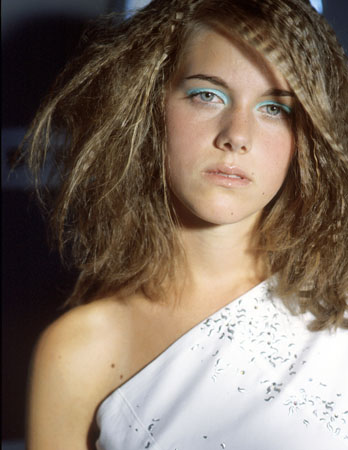
What is it that leads us to describe someone, in the western world usually a woman, as "beautiful"? Is beauty a universal human quality, a cultural ideal that changes with time and as we move around the world, or is it just in the eye of the beholder? The secrets of beauty and consequent attractiveness have been sought for centuries. In today's modern world women, and some men, spend a significant percentage of their incomes on looking their best. There must surely be some advantage in being beautiful or attractive.
Whether it is fair or unfair, good or bad, idealistic or practical, people we describe as beautiful tend to be more popular and may be regarded more favourably by those around them. They may get preferential treatment as children from parents or teachers, and at least a more sympathetic hearing as adults from employers, fellow employees, the police and even the legal system. Perhaps it is just more difficult to be angry or upset when confronted by a beautiful smile.
In the modern western world a woman is considered beautiful if her body has certain physical characteristics - a slim figure and waist, long and shapely legs, firm breasts of an attractive size and shape, and of course a particular set of facial characteristics. These characteristics are, however, not universal or timeless. As recently as the Victorian era a beautiful woman had fuller figures - just look around a few art galleries and observe the body shapes of the models artists chose to paint.
In Mauritania, obesity is revered and regarded as desirable among the white Moor Arab population, and young girls overfed at so-called fattening farms to the point of endangering their health. Overweight woman are seen in considerable numbers and are associated with health, wealth, happiness and fertility. This practice is fortunately in decline but still exists in many rural areas. In the island of Tonga, in the South Pacific, beauty is again closely associated with large physical size. 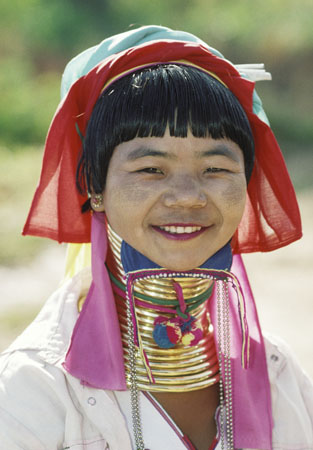 This predilection seems to be related to diet but also has roots in heredity and custom. In Ghana, men are again reported to prefer women with an above-average body weight. Compare this with western values and practices, where women strive to achieve a slim figure and consequently attend gymnasiums and exercise classes. The driving force is the same - a desire to conform to an idealized western body shape thought to represent health and fertility. In the US, UK, France and Italy men have a reported preference for women who have below average body weight.
This predilection seems to be related to diet but also has roots in heredity and custom. In Ghana, men are again reported to prefer women with an above-average body weight. Compare this with western values and practices, where women strive to achieve a slim figure and consequently attend gymnasiums and exercise classes. The driving force is the same - a desire to conform to an idealized western body shape thought to represent health and fertility. In the US, UK, France and Italy men have a reported preference for women who have below average body weight.
Whatever the nature of the physical characteristics of beauty, it seems they are not all universal. Cultural influences are readily apparent. However, there also clearly much more to it than just body weight and shape - yes, it gets more complicated and confusing! Both adornment and facial characteristics must be added in to the mix.
Good looks and personal qualities, youth, and liberal attitudes are arguably the principal and most natural means of being favourably regarded by others. However, in the absence of some or all of these characteristics, woman all over the world resort to art and other artificial means to adorn themselves and hence become more attractive. Jewellery, make-up and perfume are perhaps the most widely used aids, although the details vary from culture to culture.
The women of the Padaung tribe, a minority group within the Karen living in the state of Kayah in Burma, have taken adornment to extremes. Young girls have metal rings placed around their necks at an early age. As the grow up, the number of rings is increased - usually in three stages. The origins of the practice remain unknown, but ask one of the women why she is adorned in this way and she may typically reply "Because we have always done it!"
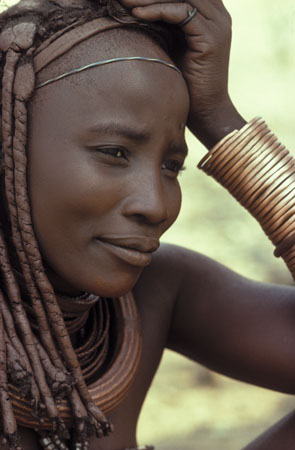 The women of the Mursi and Surma tribes in the Omo River region of Ethiopia insert plates in their lower lips. The process begins prior to marriage when a rounded peg is inserted in the lip. Once the incision has healed the diameter of the peg is gradually increased until it can be replaced by an ornamented clay, wooden or ceramic plate. The final diameter of the plate ranges from about 10 cm to over 20 cm. In this culture, big lips are considered attractive. In the western world the culture is totally different - yet uncannily similar.
The women of the Mursi and Surma tribes in the Omo River region of Ethiopia insert plates in their lower lips. The process begins prior to marriage when a rounded peg is inserted in the lip. Once the incision has healed the diameter of the peg is gradually increased until it can be replaced by an ornamented clay, wooden or ceramic plate. The final diameter of the plate ranges from about 10 cm to over 20 cm. In this culture, big lips are considered attractive. In the western world the culture is totally different - yet uncannily similar.
The women of the Himba tribe, who live in the northern part of Namibia and the southern areas of Angola, are extraordinarily dignified and graceful. Their traditional attire leaves them almost naked, and the rich reddish brown colour of their skin is the first thing one notices. A mixture of ochre and butterfat, sometimes combined with aromatic herbs, is routinely used to cover every part of the body and clothing. The use of this attractive but rancid cosmetic is characteristic of the Himba, and regarded as a basis for good grooming, beauty and sound health. The result is a stunning monochromatic effect with perfectly matched skin, hair, and leather clothing and adornments.
Burmese women adorn their faces with thanaka, a fine powder made by grinding aromatic wood on a stone and mixing it with water to create a paste. The women use it not only for its original purpose of protecting the skin against the harsh sun, but also as a cosmetic. They cover their faces with the paste and then use a matchstick to draw leaves or other decorative objects on their cheeks and foreheads.
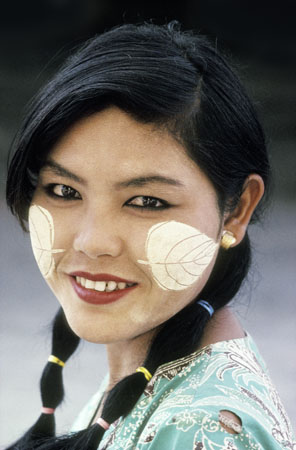
Western women tattoo their bodies, sometimes in the most intimate manner, and pierce ears, noses, tongues and nipples to insert rings of various descriptions. They also undergo surgery to insert silicone breast implants, presumably to enhance attractiveness, confidence or self esteem, and opt for other surgical procedures that remove fat, reduce waist size and alter the appearance of lips and other parts of the body. Such practices are surely comparable with those used in other parts of the world, a few of which are recounted above.
One further aspect of beauty that is clearly important is the geometry of the face itself. Facial symmetry has often been shown to be a factor in the assessment of beauty although it is by no means a measure in its own right. Take a head and shoulders portrait from directly in front of a model's face and, using image processing software, slice the image vertically down the centre of the nose and delete one half. Then reverse the remaining half and add it seamlessly to the image so that left and right halves are identical. Some minor adjustments may have to be made to accommodate a normal head of hair, highlights on lips etc. The resulting image is sometimes hauntingly more beautiful than the original real-life image, although it can in some cases also appear unnatural. An example of this type of manipulation is shown below in the picture of the model with a yellow feather in her hair. However, as always, there are contradictions. Some models have asymmetrical facial geometry, dimples or other features such as prominent mole spots that add beauty and individuality. There are no golden, unbreakable rules.
When we recognize a face as beautiful we are in most cases making a subconscious assessment of health and vitality. Facial symmetry and smooth blemish-free skin indicate freedom from disease and perhaps the the inheritance of genes that keep the individuals in such a healthy state. Such a person is judged to potentially make a good mother (or father). A non-symmetrical face may indicate damage caused by disease or some sort of genetic disturbance.
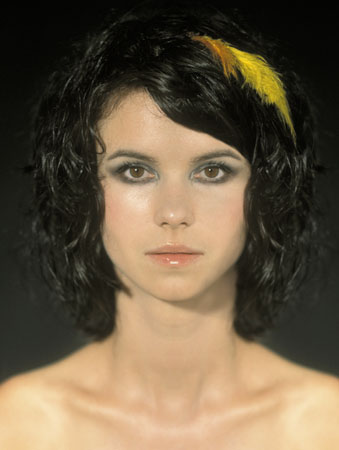 Countless surveys and investigations have been done over the years to identify what might be described as an idealized beautiful female face. The results tend to reflect the opinions of men, although investigations conducted with women produce very similar views about the characteristics that constitute beauty. An ideal female face apparently features relatively high cheek bones, a thin jaw, large and wide-opening eyes with contrasting eye and skin colours, full lips, thick hair, a small nose and smooth glowing skin. These characteristics and certain facial proportions change as a person develops in from childhood to adulthood. Idealized facial proportions, including the size of the nose, mouth and eyes, and the distance between eyes, eyes and nose, eyes and mouth etc, seem to occur in women at about the age of 25.
Countless surveys and investigations have been done over the years to identify what might be described as an idealized beautiful female face. The results tend to reflect the opinions of men, although investigations conducted with women produce very similar views about the characteristics that constitute beauty. An ideal female face apparently features relatively high cheek bones, a thin jaw, large and wide-opening eyes with contrasting eye and skin colours, full lips, thick hair, a small nose and smooth glowing skin. These characteristics and certain facial proportions change as a person develops in from childhood to adulthood. Idealized facial proportions, including the size of the nose, mouth and eyes, and the distance between eyes, eyes and nose, eyes and mouth etc, seem to occur in women at about the age of 25.
A human face acknowledged as beautiful, when carefully analyzed using modern techniques to measure proportions, normally incorporates numerous ratios close to the so-called golden section. Also known as golden ratio or divine proportion, this is a constant equal to about 1.618. This ratio has a long history and was used extensively by Leonardo da Vinci prior to the creation of his various masterpieces. It may also be found in the adornments recovered from Tutankhamun's tomb and of course in great Greek and Egyptian architecture.






